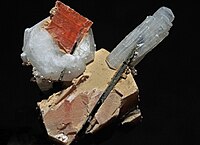
Photo from wikipedia
Flexibly bound heavy adsorbates as antibodies, biomarkers, microbeads, bacteria do not produce response at quartz resonators accounted by their mass alone, which complicates their acoustic detection. To resolve this problem,… Click to show full abstract
Flexibly bound heavy adsorbates as antibodies, biomarkers, microbeads, bacteria do not produce response at quartz resonators accounted by their mass alone, which complicates their acoustic detection. To resolve this problem, an anharmonic detection technique (ADT) has been developed. It generates higher harmonics by applying a high voltage (0.7–10 V) fundamental frequency excitation to 14.3 MHz AT-cut quartz crystal. Due to non-linearity the parameters of generated oscillations depend on the amplitude A of the applied signal, being proportional to A2 for the fundamental resonance frequency and mainly to A3 for the amplitude of generated 3rd harmonics. The coefficients of proportionality depend on number of attached particles, but not on their mass and can be calculated from the phenomenological model based on Duffing equation with damping. The model was tested in liquids of various viscosity, on composite layer including polymer film with deposited gold nanoparticles and in electrochemical mode for E.-coli adsorption.
Journal Title: Electrochimica Acta
Year Published: 2017
Link to full text (if available)
Share on Social Media: Sign Up to like & get
recommendations!